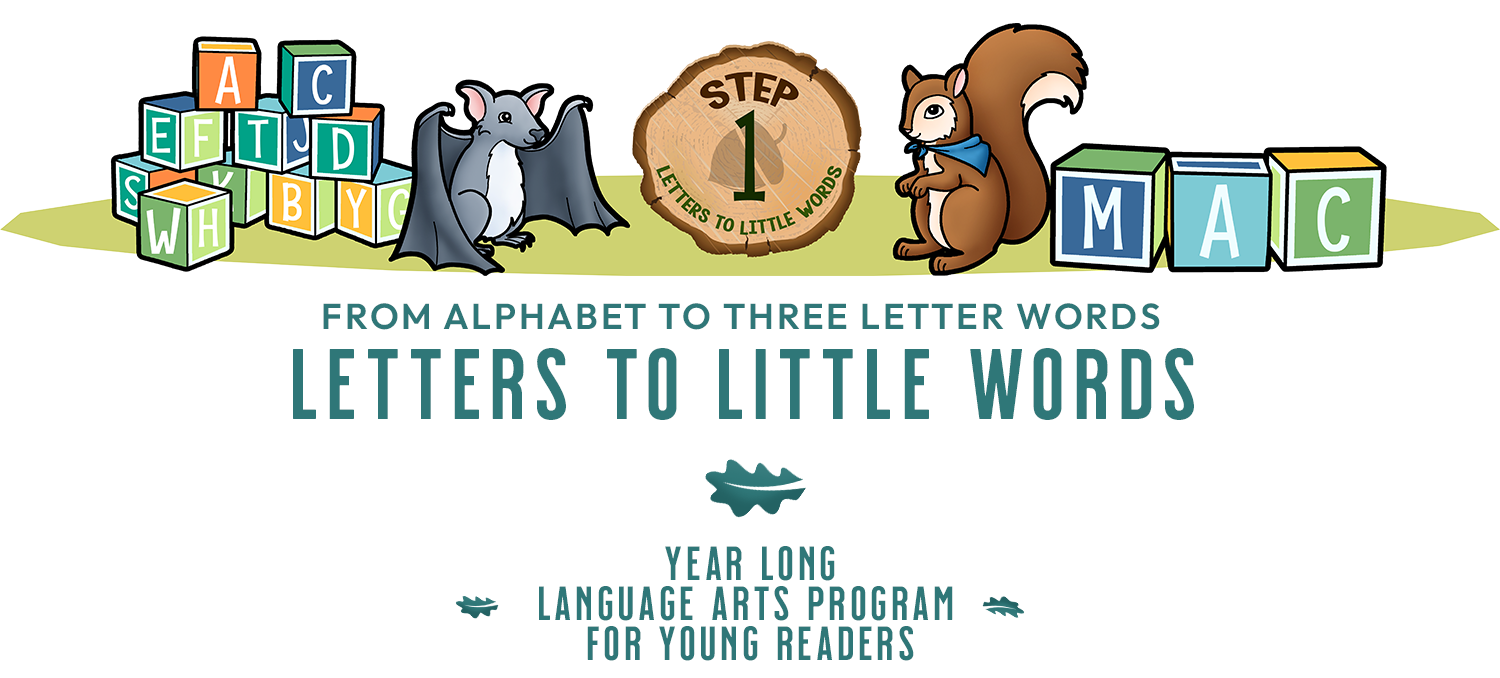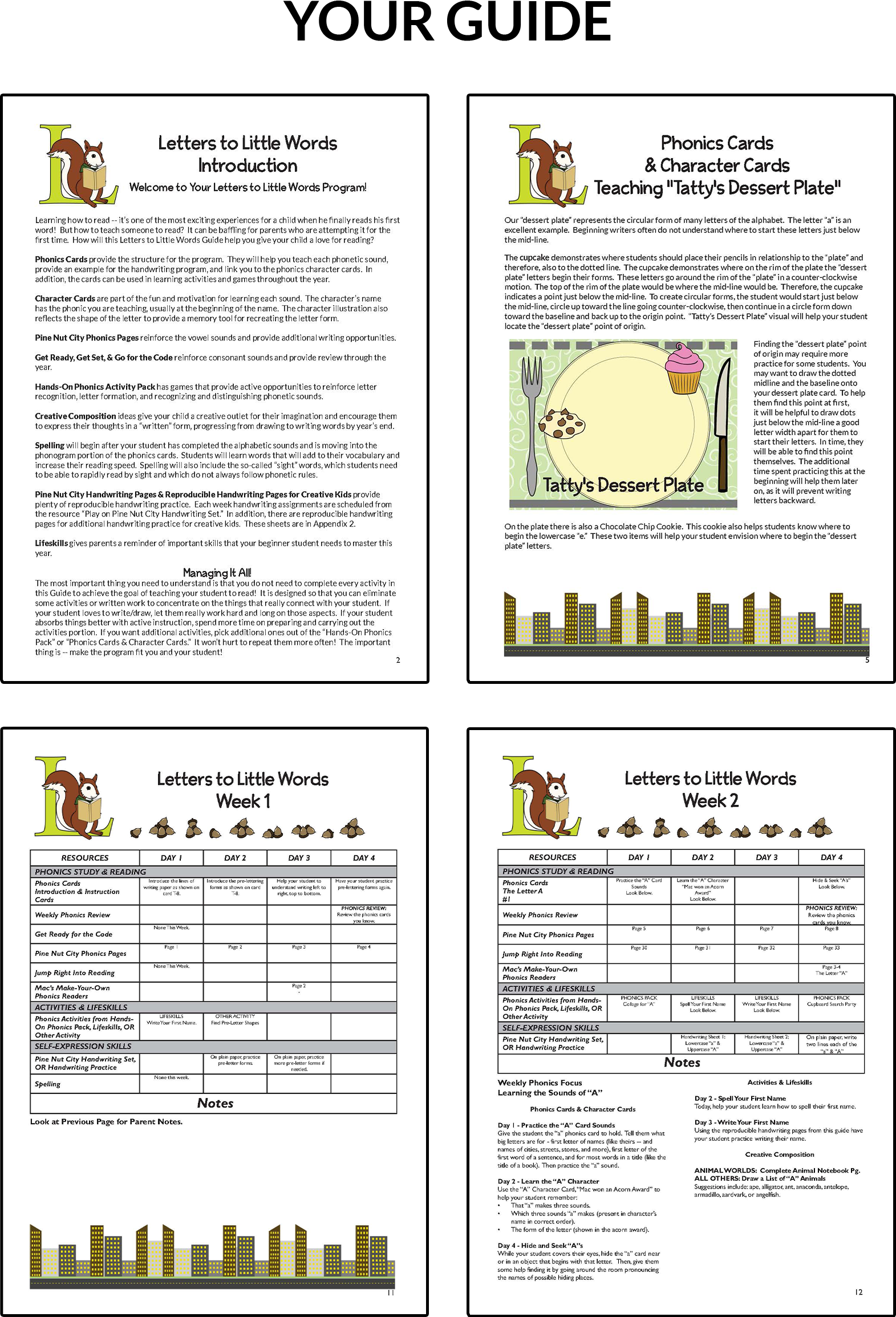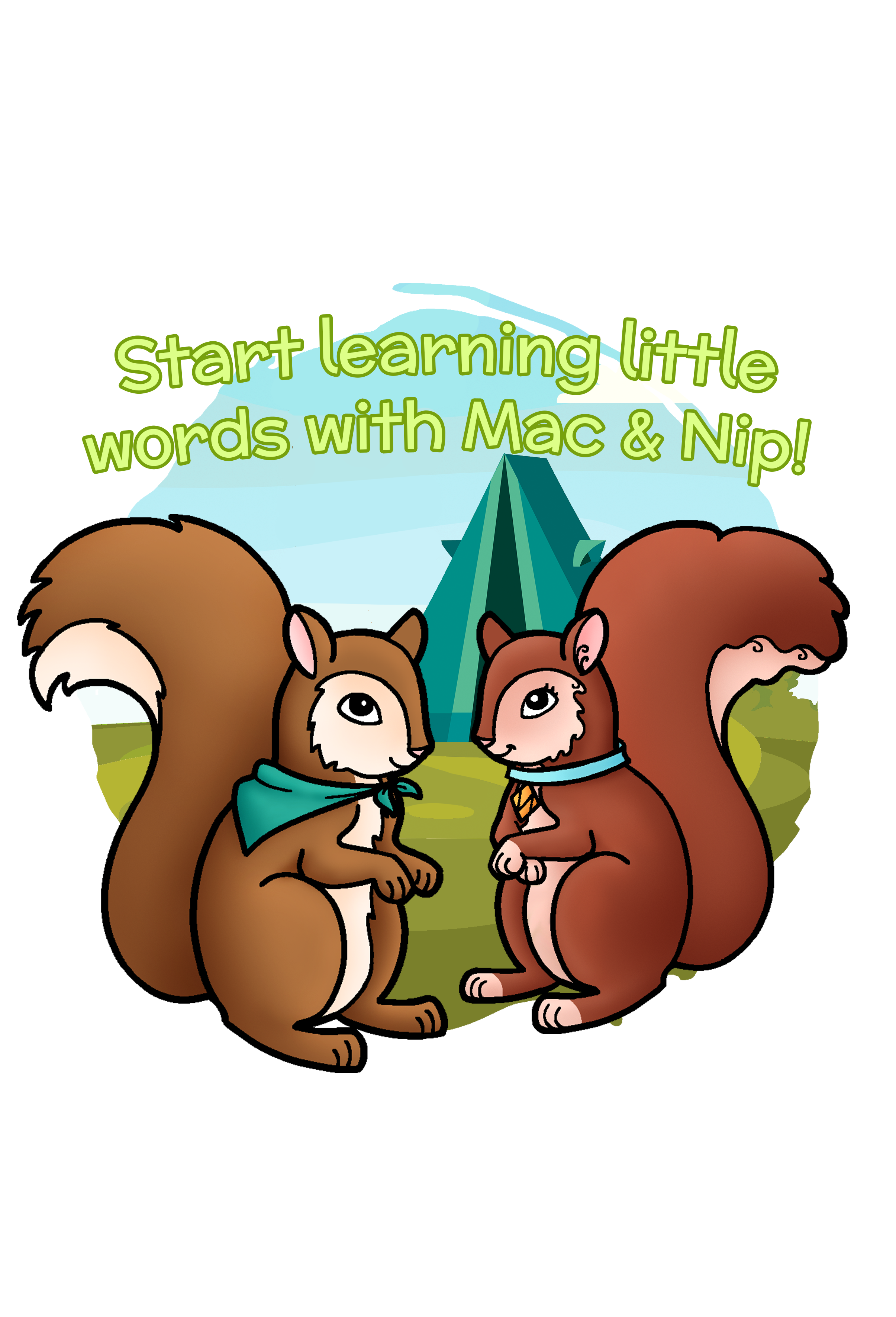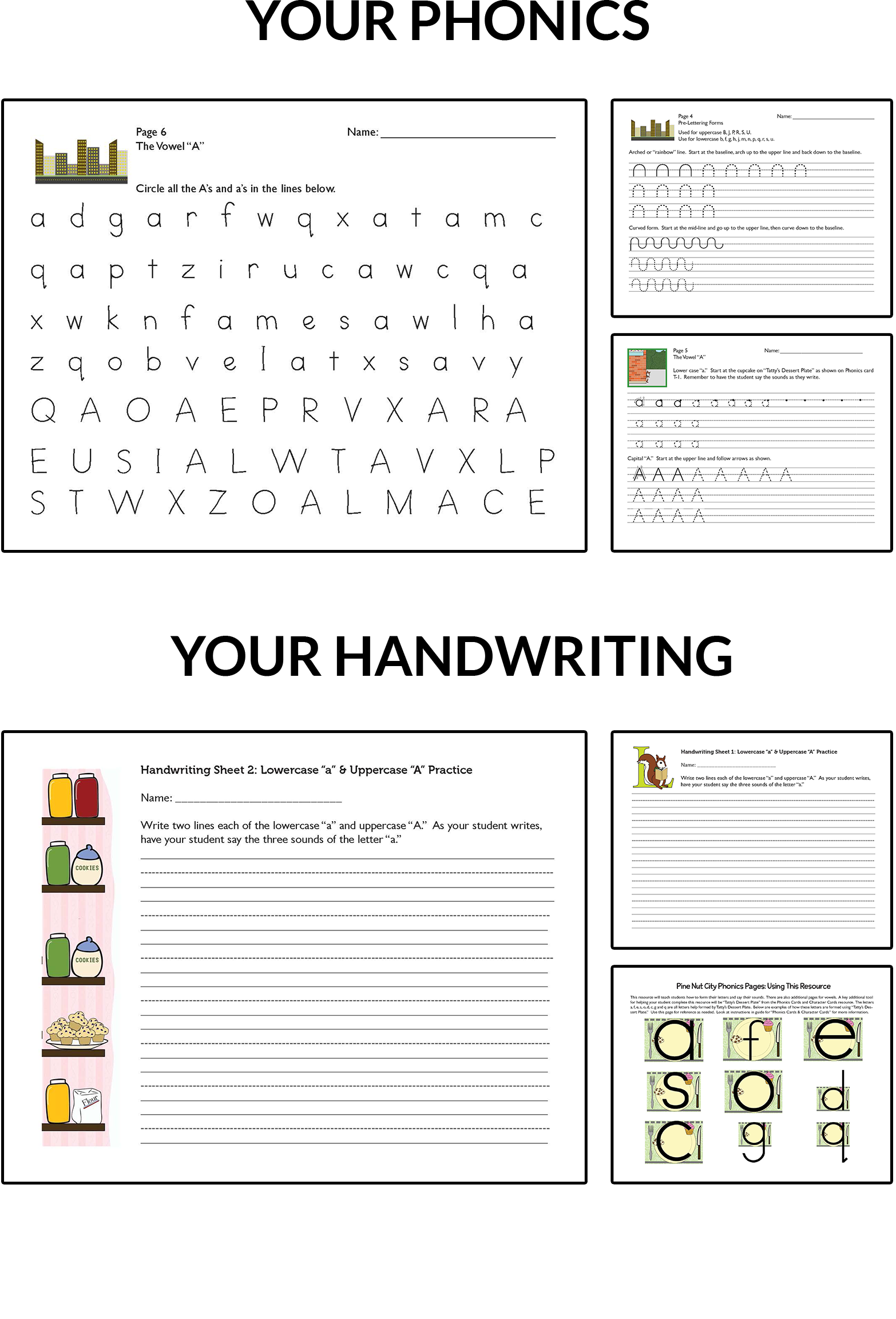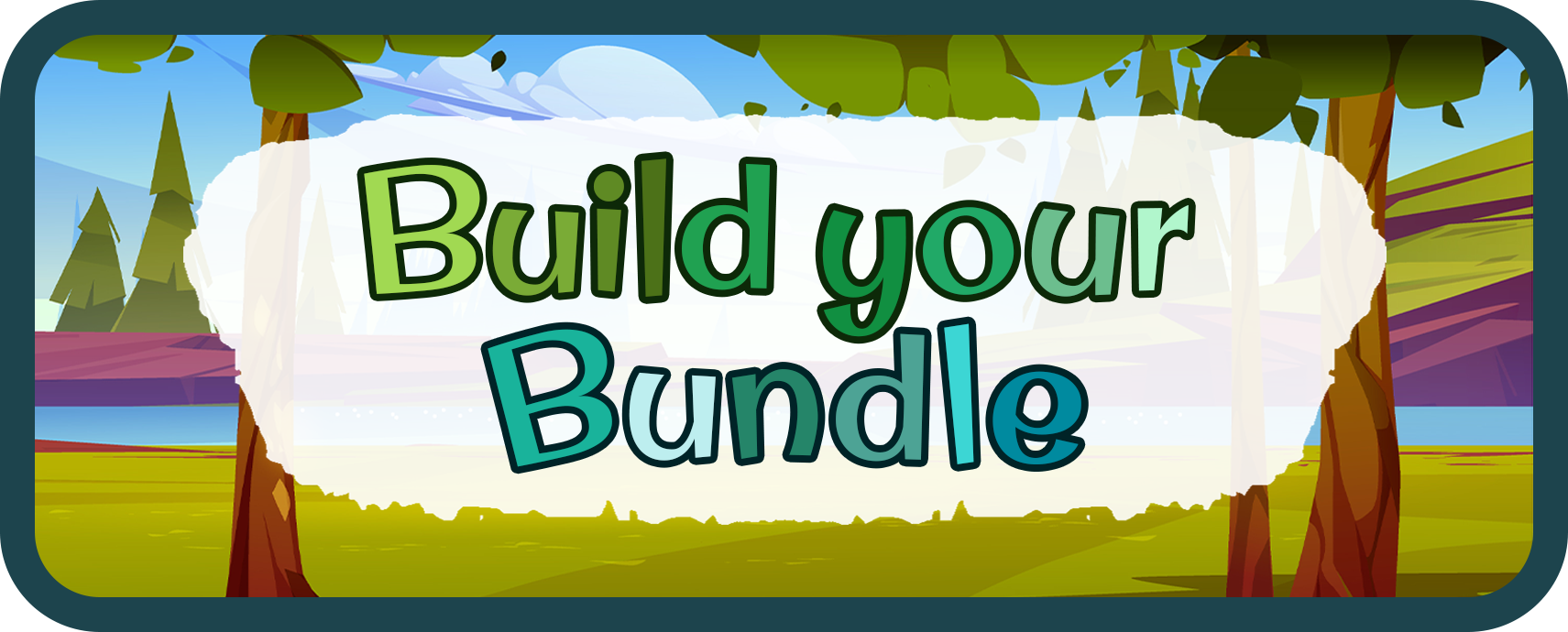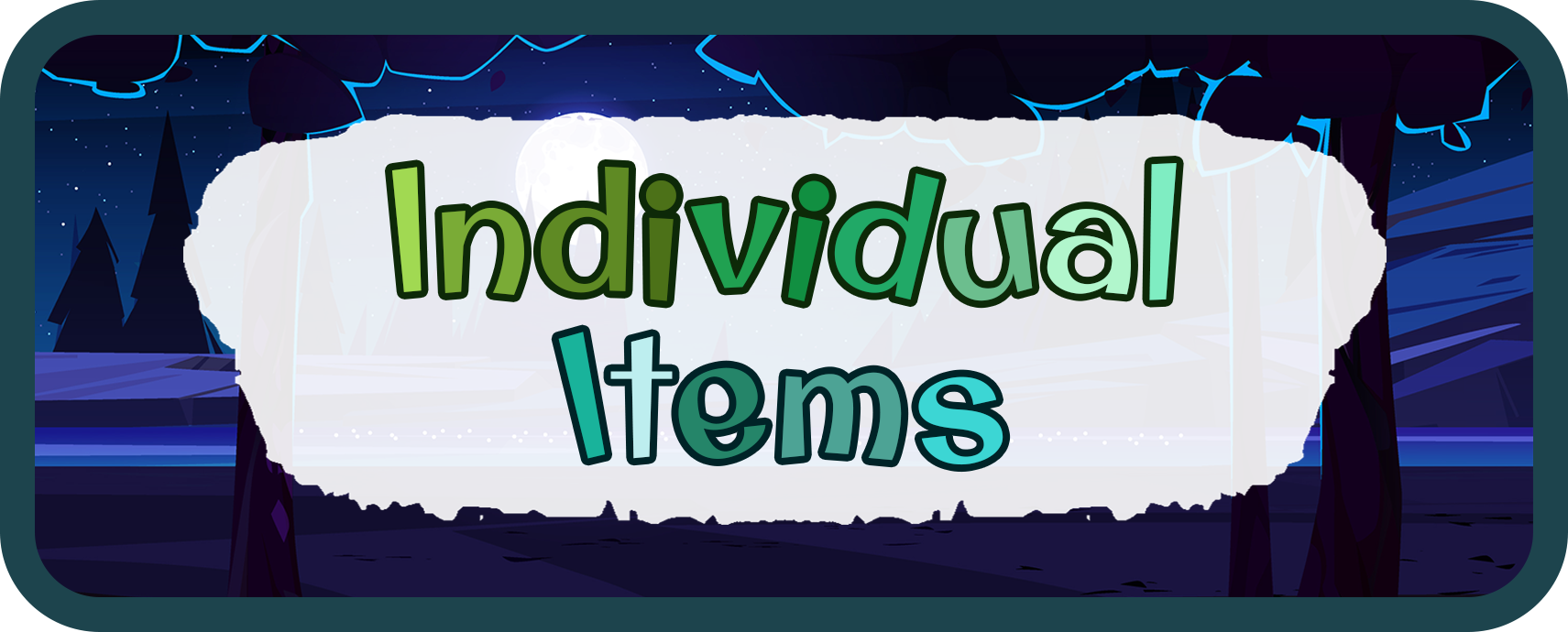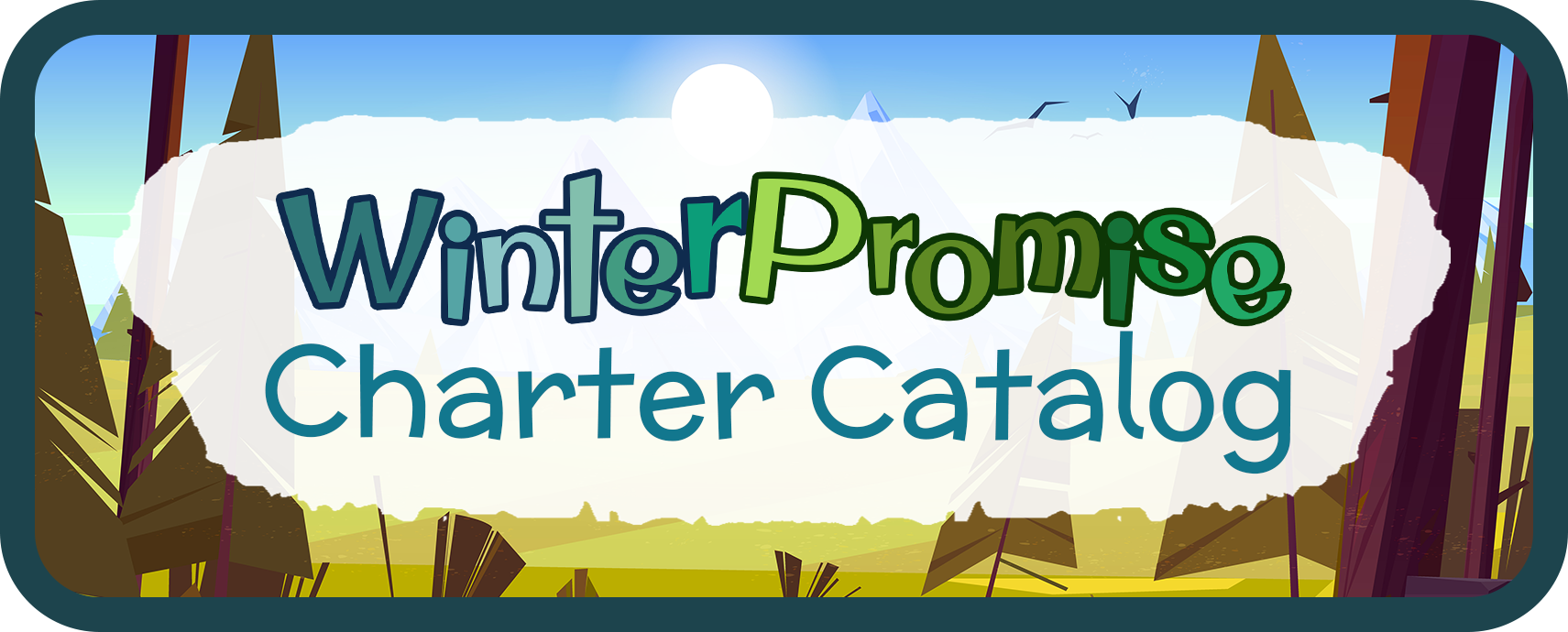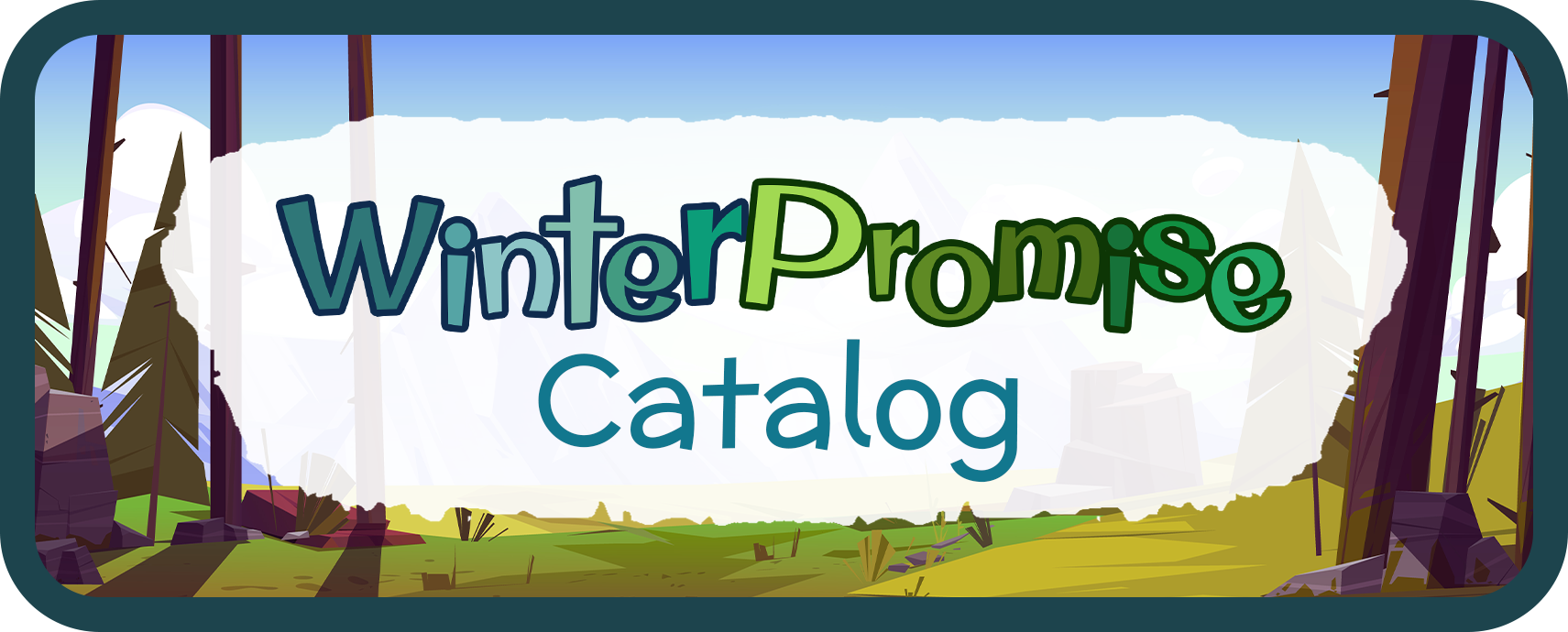Letters to Little Words is a year-long language arts program designed for students who show readiness to learn the sounds of the alphabet and other phonograms, or for students who have begun to learn, but not mastered, most of the phonetic sounds of the alphabet. In this program, students will learn alphabet letter identification, sounds, and formation. This program works great for students who haven’t yet worked on the alphabet and those who have had some instruction!
Click the Circle Below to purchase!
Keep scrolling to learn more!
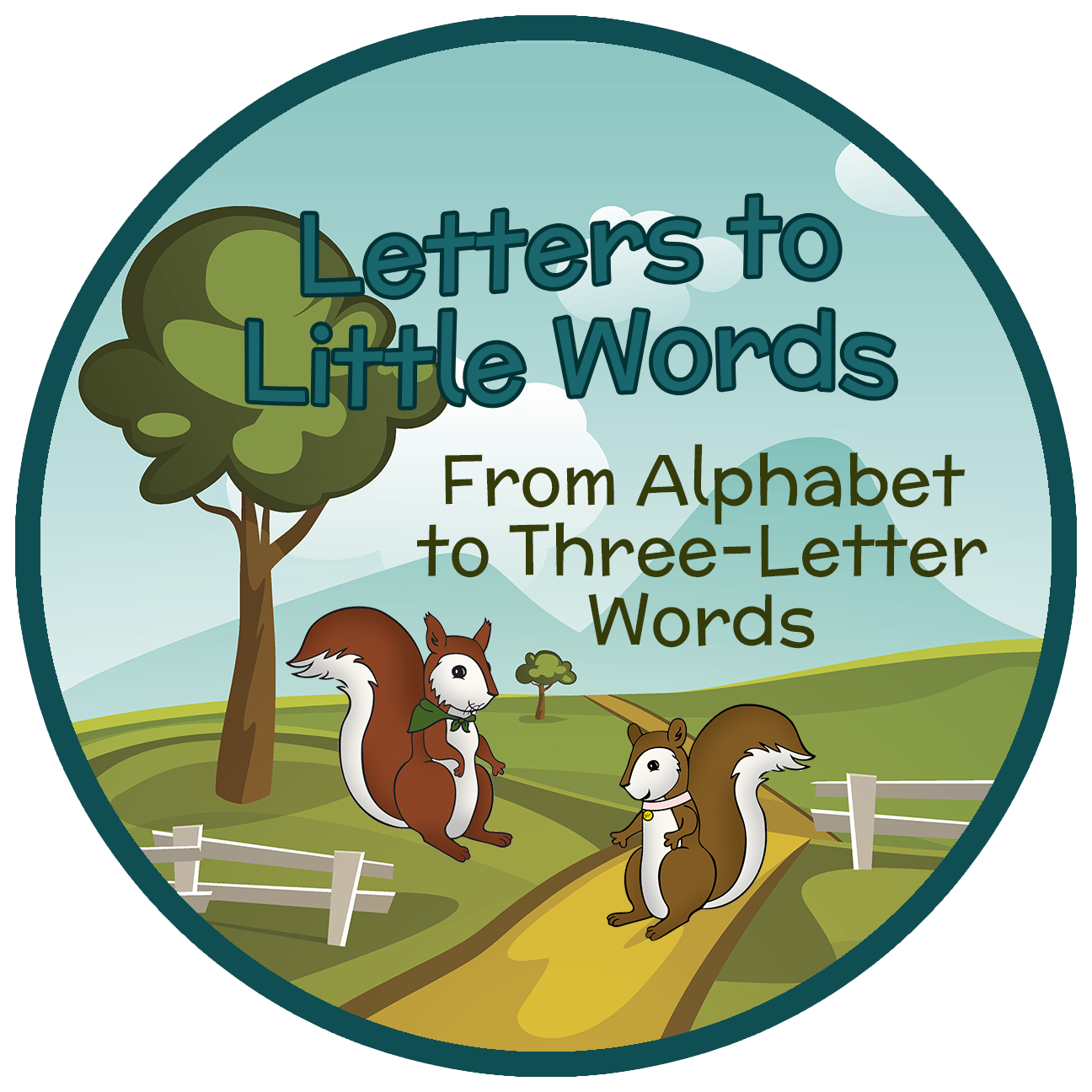
Bundles Starting as Low as $137!
If you have any questions while purchasing please reach out to one of our Curriculum Specialists! Click here to learn more about how you can get in touch with our team!
Click through the options below to learn more about the resources found in this program!
Letters to Little Words
What’s in the Letters to Little Words Guide?
This “Letters to Little Words” Guide is set-up in a 4-day format to be completed in 36-weeks, a full school year. This guide schedules phonics practice, creative phonics activities, phonics workbooks, phonics games, letter and phonogram flashcards, basic informal spelling activities, handwriting, creative composition, interactive phonics worksheets, and teaching for basic life skills. This guide includes bonus handwriting originals, helpful weekly parent notes, instructions for use and teaching of materials within the program, and other additional helps and charts.
The different aspects of this program listed above use varying materials: student workbooks, interactive worksheets, hands-on games and activities, and crafts. The resources “Hands-On” Phonics Pack, Phonics Cards & Character Cards, and “Mac’s Make-Your-Own” Phonics Readers provide ample opportunity for game ideas, cut-and-paste practice, hands-on phonics games, sounding out letters and phonograms practice, and fun!
Also as part of this guide are blank handwriting originals, teacher helps, and answer key. Scheduled student workbooks such as the “Get Ready for the Code,” “Get Set for the Code,” “Go for the Code,” and “Jump Right Into Reading” reinforce the same skills but in a different format.
The amount of handwriting in this program can easily be increased or decreased depending on the students’ ability. Spelling activities and creative composition are scheduled weekly within the guide. The spelling activities and creative composition are optional and can be used at the discretion of the parent.
More advanced or older students may complete all or only part of these optional resources in the guide. Younger students may not be ready to complete this portion of the program but they may later on in the year. Finally teaching instructions and reminders for helping students to understand basic life skills are part of this guide as well. This “Letters to Little Words” Guide with its many opportunities for fun, easy-to-use structured guide, learning with workbooks and games, and the use of many different learning styles makes it a wonderful guide to teaching your student to read.
Encouraging Your Student’s Learning Style
Another great aspect of this program is the ability to embrace using one or more of the learning styles; a few of them; or all of the different learning styles for teaching the material in this program. If your student struggles with learning through workbooks but loves learning with their hands – complete more of their learning with the “Hands-On” Phonics Pack, “Make-Your-Own” Phonics Readers, and the Phonics Cards and Character Cards. You can also schedule in more practice with these resources.
If you student loves to write and enjoys handwriting use more of the handwriting originals, student workbooks, and creative composition assignments. If you find your student easily verbalizes the things they’ve learned then complete more of the assignments orally. This learning styles is easy to work with as the student workbooks, spelling activities, creative composition, and so on can be done orally while their writing skills and fine-motor skills “catch-up.”
It is understood that if you choose to focus on one learning style that you don’t have to skip the other portion of the program. You can complete the program at a slower rate. If you still want to complete the program in one school year you can complete less of the activities or student worksheets. The multiple learning styles provide flexibility in learning that is unique to WP!
What will you study in the Letters to Little Words Resources?
List of the Student Resources
- Hands-On Phonics Activity Pack
- Phonics Cards & Character Cards
- “Make-Your-Own” Phonics Readers
- Get Ready for the Code Student Workbook A
- Get Set for the Code Student Workbook B
- Go for the Code Student Workbook C
- Jump Right Into Reading Student Workbook
Concepts “Letters to Little Words” Covers:
Week 1: Alphabet & Life Skills – spelling their name
Week 2: Letter “A” & Life Skills – spelling their name
Week 3: Letter “F” & Life Skills – spelling their name; memorize their home phone number
Week 4: Letter “B” & Life Skills – memorize their home phone number
Week 5: Letter “M” & Life Skills – spelling their name; memorize their home phone number
Week 6: Letter “E” & Life Skills – teach how to answer the phone
Week 7: Letter “K” & Life Skills – practice answering the phone
Week 8: Letter “T” & Life Skills – teach how to make a phone call
Week 9: Letter “R” & Life Skills – create a phone number chart
Week 10: Letter “I” & Life Skills – emergency phone numbers
Week 11: Letter “P” & Life Skills – teach about liquid/solid measurements
Week 12: Letter “S” & Life Skills – liquid/solid measurements practice
Week 13: Letter “N” & Life Skills – teach the names of the days of the week
Week 14: Letter “O” & Life Skills – teach about how to use a calender & days of the week
Week 15: Letter “J” & Life Skills – continue practice using a calender & the days of the week; teach the names of the months in the year
Week 16: Letter “H” & Life Skills – continued practice of their knowledge of the calender & months in the year
Week 17: Letter “D” & Life Skills – continued practice of their knowledge of the calender & months in the year
Week 18: Letter “U” & Life Skills – continued practice of their knowledge of the calender & months in the year
Week 19: Letter “C” & Life Skills – continued practice of their knowledge of the calender & months in the year
Week 20: Letter “L” & Life Skills – teach about table manners
Week 21: Letter “G” & Life Skills – continued practice of their table manners
Week 22: Letter “W” & Life Skills – continued practice of their table manners
Week 23: Letter “Y” & Life Skills – continued practice of their table manners
Week 24: Letter “V” & Life Skills – teach student how to tie their shoes
Week 25: Letter “Z” & Life Skills – continued practice tying their shoes
Week 26 Letter “QU” & Life Skills – teach student what to do if lost & what to do in a public place
Week 27: Letter “X” & Life Skills – teach student about fire safety
Week 28: Phonograms “EE” & “OA” & Life Skills – teach student what to do in a tornado
Week 29: Phonograms “EAR,” “IR,” & “UR” & Life Skills – teach student about water safety
Week 30: Phonograms “ER” & “WOR” & Life Skills – teach student how to cross the street safely
Week 31: Phonograms “SH” & “TH”& Life Skills – teach student about strangers
Week 32: Phonograms “CH,” “PH,” & “WH”& Life Skills – teach student their home address & review of previous safety concepts
Week 33: Phonograms “AY,” “AI,” “OY,” & “OI” & Life Skills – show student where you live on a map
Week 34 Phonograms “AW” & “AU;” Phonics “KN” & “GN” & Life Skills – teach student how to use a can opener
Week 35: Phonograms “AR;” & Phonics “CK” & “NG”& Life Skills – review how to tie shoes, days of the weeks, and home phone number
Week 36 Phonograms “OR” & Phonics “TCH” & “DGE” & Life Skills – practice telephone skills & create a fire escape plan
Pine Nut City Phonics Pages:
This is a consumable student resource. In these phonics pages your student will be taught letter formation and shapes through guided handwriting pages. It also includes phonics pages for the four vowels: a, e, i ,o and u.
Pine Nut City Handwriting Set:
The resource, “Pine Hollow Handwriting Set,” is used weekly throughout the language arts program, “Letters to Little Words.” There are thirty-six interactive handwriting pages. Each page has a picture, a handwriting exercise, and blank lines to complete the exercise. Exercises vary and help students practice skills they’ve learned from their “Letters to Little Words” guide.
Students that struggle with handwriting can complete the handwriting pages once-a-week and not get discouraged, while still getting the necessary practice. For student who enjoy handwriting extra opportunity is provided. In the “Letters to Little Words” guide, blank handwriting pages are included, along with extra handwriting ideas.
Mac's Make-Your-Own Phonics Readers:
This resource helps students to use their cutting and pasting skills while they practice sounding out and reading small words. The fun cut-apart booklet has places to draw and color in it for the student to get creative.
Get Ready for the code!
The workbook, “Get Ready for the Code,” focuses on the letters “b,” “f,” “m,” “k,” and “t” and vowels. This is the first of the three books in this series. This workbook and following two workbooks is scheduled in the “Letters to Little Words” program. This workbook gives students practice identifying letters, matching objects to words, handwriting, copying, and fine motor skills.
Get Set for the Code!
The workbook, “Get Set for the Code,” focuses on the letters “p,” “s,” “n,” “j,” “h,” and “d.” This is the second of the three books in this series. This workbook and the other two workbooks is scheduled in the “Letters to Little Words” program. This workbook gives students practice identifying letters, matching objects to words, handwriting, copying, and fine motor skills.
Go for the Code!
The workbook, “Go for the Code,” focuses on the letters “c,” “l,” “g,” “w,” “y,” “v,” “z,” and “q.” This is the last of the three books in this series. This workbook and the previous two workbooks is scheduled in the “Letters to Little Words” program. This workbook gives students practice identifying letters, matching objects to words, handwriting, copying, and fine motor skills. Once they complete these three workbooks your student will have covered all twenty-six letters.
Jump Right into Reading
This resource includes reading and interactive pages that help teach early language skills, capitalization, letter formation, and reading comprehension. This workbook has over 200 pages of interactive workbook pages and reading.
Want to Dive Deep?
Click here to learn more about our Adventures in Pine Hollow Programs and dive deep into what your student will learn!


